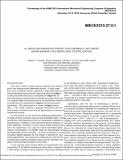| dc.contributor.author | Chester, Shawn Alexander | |
| dc.contributor.author | Srivastava, Vikas | |
| dc.contributor.author | Di Leo, Claudio V | |
| dc.contributor.author | Anand, Lallit | |
| dc.date.accessioned | 2018-10-22T12:29:47Z | |
| dc.date.available | 2018-10-22T12:29:47Z | |
| dc.date.issued | 2010-11 | |
| dc.identifier.isbn | 978-0-7918-4446-5 | |
| dc.identifier.uri | http://hdl.handle.net/1721.1/118630 | |
| dc.description.abstract | The most common shape-memory polymers are those in which the shape-recovery is thermally-induced. A body made from such a material may be subjected to large deformations at an elevated temperature above its glass transition temperature θg . Cooling the deformed body to a temperature below θ g under active kinematical constraints fixes the deformed shape of the body. The original shape of the body may be recovered if the material is heated back to a temperature above θ g without the kinematical constraints. This phenomenon is known as the shape-memory effect. If the shape recovery is partially constrained, the material exerts a recovery force and the phenomenon is known as constrained-recovery . As reviewed by [1], one of the first widespread applications of shape-memory polymers was as heat-shrinkable tubes. Such rudimentary early applications did not necessitate a detailed understanding or modeling of the thermomechanical behavior of these materials. However, in recent years shape-memory polymers are beginning to be used for critical biomedical applications, microsystems, re-writable media for data storage, and self-deployable space structures. In order to develop a robust simulation-based capability for the design of devices for such critical applications, one requires an underlying accurate thermo- mechanically-coupled constitutive theory and an attendant vali- dated numerical implementation of the theory. In the past few years several efforts at experimental characterization of the thermo-mechanical stress-strain response of a wide variety of shape-memory polymers have been published in the literature [1, 2] to name a few. Significant modeling efforts have also been published [2, 3] to name a few. However, at this point in time, a thermo-mechanically-coupled large-deformation constitutive theory for odeling the response of thermally-actuated shape-memory polymers is not widely agreed upon — the field is still in its infancy. The purpose of this manuscript is to present results from of our own recent [4], and ongoing research in this area. Specifically, with the aim of developing a thermo-mechanically-coupled large-deformation constitutive theory and a numerical simulation capability for modeling the response of thermally-actuated shape-memory polymers, we have (i) conducted large strain compression experiments on a representative shape-memory polymer to strains of approximately unity at strain rates of 0⁻³ s⁻¹ and 10⁻¹ s⁻¹, and at temperatures ranging from room temperature to approximately 30 C above the glass transition temperature of the polymer; (ii) formulated a thermo-mechanically-coupled large deformation constitutive theory; (iii) calibrated the material parameters appearing in the theory using the stress-strain data from the compression exper- iments; (iv) numerically implemented the theory by writing a user-material subroutine for a widely-used finite element program; and (v) conducted representative experiments to validate the predictive capability of our theory and its numerical implementation in complex three-dimensional geometries. By comparing the numerically-predicted response in these validation simulations against measurements from corresponding experi- ments, we show that our theory is capable of reasonably accurately reproducing the experimental results. Also, as a demonstration of the robustness of the three-dimensional numerical ca- pability, we show results from a simulation of the shape-recovery response of a stent made from the polymer when it is inserted in an artery modeled as a compliant elastomeric tube. Furthermore, as is well known, when the shape-memory polymer recovers from its temporary shape it returns stored en- ergy and can serve as a thermally-activated actuator. Due to the low rubbery modulus of the polymer above the glass transition temperature, its actuation force is limited and the material is thus restricted form numerous applications where “high” actu- ation forces are required. To combat the problem of low actuation force of shape-memory polymers, we have synthesized re- inforced shape-memory polymer composites using superelastic nitinol wires. Specifically with these reinforced composites we have (i) conducted thermo-mechanical three-point bend experiments on samples with and without nitinol wires. In these exper- iments the deformation is constrained so as to measure the ac- tuation force; (ii) numerically simulated the thermo-mechanical response of the shape-memory polymer composite in the afore- mentioned condition of constrained recovery using the simula- tion capability developed. The numerical predictions are in good agreement with the experimental results of constrained-recovery of the reinforced shape-memory composites. | en_US |
| dc.publisher | ASME International | en_US |
| dc.relation.isversionof | http://dx.doi.org/10.1115/IMECE2010-37383 | en_US |
| dc.rights | Article is made available in accordance with the publisher's policy and may be subject to US copyright law. Please refer to the publisher's site for terms of use. | en_US |
| dc.source | ASME | en_US |
| dc.title | A Large-Deformation Theory for Thermally-Actuated Shape-Memory Polymers and its Application | en_US |
| dc.type | Article | en_US |
| dc.identifier.citation | Chester, Shawn A., Vikas Srivastava, Claudio V. Di Leo, and Lallit Anand. “A Large-Deformation Theory for Thermally-Actuated Shape-Memory Polymers and Its Application.” Volume 9: Mechanics of Solids, Structures and Fluids | en_US |
| dc.contributor.department | Massachusetts Institute of Technology. Department of Mechanical Engineering | en_US |
| dc.contributor.mitauthor | Chester, Shawn Alexander | |
| dc.contributor.mitauthor | Srivastava, Vikas | |
| dc.contributor.mitauthor | Di Leo, Claudio V | |
| dc.contributor.mitauthor | Anand, Lallit | |
| dc.relation.journal | Volume 9: Mechanics of Solids, Structures and Fluids | en_US |
| dc.eprint.version | Final published version | en_US |
| dc.type.uri | http://purl.org/eprint/type/ConferencePaper | en_US |
| eprint.status | http://purl.org/eprint/status/NonPeerReviewed | en_US |
| dc.date.updated | 2018-10-19T17:41:53Z | |
| dspace.orderedauthors | Chester, Shawn A.; Srivastava, Vikas; Di Leo, Claudio V.; Anand, Lallit | en_US |
| dspace.embargo.terms | N | en_US |
| dc.identifier.orcid | https://orcid.org/0000-0002-4581-7888 | |
| mit.license | PUBLISHER_POLICY | en_US |
